Hwarang Guesthouse [Korea Quality] / 화랑게스트하우스[한국관광 품질인증]
11.2Km 2023-04-13
136-1, Wonhyo-ro, Gyeongju-si, Gyeongsangbuk-do
+82-10-2473-8329
Hwarang Hostel is located near Daereungwon in Gyeongju.
The three-story guest house has ten rooms in all, and there are two types of rooms - double and quad. Every room is equipped with exclusive toilet and bathroom for the user’s convenience.
The atmosphere of the lobby on the first floor is very relaxing and cozy, furnished with various kinds of books including travel guides.
Communal PC and fax, refrigerator, and washing facility are available. Daereungwon ancient tombs, Cheomseongdae observatory, and Donggung & Wolji palace site are within walking distance from the guest house.
Hwarang Hostel boasts of the best location considering the transportation and tourist destinations. You can also rent a bike for 7,000 won a day.
Gare de Gyeongju (경주역)
11.2Km 2021-03-17
266, Wonhwa-ro, Gyeongju-si, Gyeongsangbuk-do(Seongdong-dong)
Situé dans le quartier de Seongdong-dong à Gyeongju-si, (province du Gyeongsangbuk-do), la gare de Gyeongju a ouvert ses portes le 1er novembre 1918. La gare, partie intégrante de la ligne Donghae Nambu, est le dernier arrêt de la ligne Jungang.
Zone historique de Gyeongju [Patrimoine mondial de l’UNESCO] (경주역사유적지구)
11.2Km 2025-03-27
757, Taejong-ro, Gyeongju-si, Gyeongsangbuk-do
+82-54-779-6100
La zone historique de Gyeongju, enregistrée au patrimoine culturel mondial de l’UNESCO en novembre 2000, personnifie l’histoire et la culture millénaires de Gyeongju, l’ancienne capitale du royaume de Silla (新羅, 57-935).
Cette zone peut être divisée en cinq grandes sections. La première, la zone de Namsan, renferme de véritables trésors de l’art bouddhiste qui datent de l’époque du royaume de Silla. Le Mont Namsan de Gyeongju, souvent décrit comme un musée à ciel ouvert, abrite de nombreux monuments historiques de la dynastie Silla, parmi lesquels Poseokjeong (site historique n° 1), Tapgok Maaejosanggun (trésor n° 201), la pagode de pierre de trois étages de Cheollyongsaji (trésor n° 1188), le Bouddha de pierre de Chilbulam Maae (trésor n° 200), la statue assise de Bouddha de Bulgok (Treasure No. 198), et 37 autres reliques du Bouddhisme.
La zone de Wolseong forme la seconde section, et marque l’emplacement d’un ancien palais du royaume de Silla. On y trouve Gyerim (site historique n°19), Imhaejeonji (site historique n° 18), qui est l’emplacement d’un palais royal de Silla, et le Cheomseongdae (trésor national n° 31), le plus vieil observatoire d’Asie. La troisième zone, celle de Daereungwon, accueille un groupement de tombes royales des rois et des reines de Silla. Non loin de là se trouvent entre autres un Gobungun (un ancien cimetière) à Nodong-ri (site historique n° 38), un autre Gobungun à Noseo-ri (site historique n° 39), un troisième Gobungun à Hwangnam-ri (site historique n° 40) et Oreung (site historique n° 172). Les archéologues ont découvert dans cette zone des reliques historiques inestimables, parmi lesquelle Geumgwan (une couronne d’or), Cheonmado (a une peinture de chevaux volants), et de nombreuses poteries. Ces trouvailles ont apporté de précieux renseignements sur la vie quotidienne du peuple vous la dynastie Silla.
La quatrième zone, celle de Hwangnyongsa, marque l’emplacement de l’ancien temple de Hwangnyongsa (site historique n° 246) et de la pagode de pierre de Bunhwangsa. Finalement, la zone de Sanseong abrite de nombreux vestiges des fortifications de la capitale. On y trouve la forteresse de Myeonghwalsanseong (site historique n°47), qu’on estime vieille de 400 ans environ.
La zone historique de Gyeongju possède au total 52 biens culturels désignés, enregistrés sur la liste du patrimoine culturel mondial.
[ Zone de Namsan(남산지구)(Site Historique) ]
- Bouddha sculpté dans la roche du temple de Borisa(보리사마애석불)(Bien culturel immatériel régional), Bouddha assis en pierre dans la vallée de Mireukgok du mont Namsan(미륵곡 석불좌상)(Trésor), Pagode en pierre à trois étages dans la vallée de Yongjangsa(용장사곡 삼층석탑)(Trésor)
- Bouddha assis sculpté dans la roche(석불좌상)(Trésor), Statue bouddhique en pierre du temple de Yonggansaji(용장사지 마애여래좌상)(Trésor), Pagode en pierre à trois étages de Cheonryongsaji(천룡사지 삼층석탑)(Trésor)
- Supports de mât de drapeau sur le site du temple de Namgansa(남간사지 당간지주)(Trésor), Puits en pierre du site de Namgansa(남간사지 석정)(Bien culturel immatériel régional), Pagode en pierre à trois étages de Namsan à Gyeongju(경주남산리 삼층석탑)(Trésor)
- Triade de Bouddhas debout en pierre de Bae-dong(경주배리 석불입상)(Trésor), Statue assise en pierre de Yuneulgok(윤을곡 마애불좌상)(Bien culturel immatériel régional), Trois tombes royales(삼릉)(Site Historique)
- Bouddha assis sculpté dans la vallée de Bulgok(불곡 석불좌상)(Trésor), Bodhisattva sculpté dans la roche au hermitage de Sinseonam(신선암 마애보살반가상)(Trésor), Bouddha sculpté dans la roche de Chilbulam(칠불암 마애석불)(Trésor)
- Groupe de statues en pierre de Tapgok(탑곡 마애조상군)(Trésor), Bouddha assis en pierre dans la vallée de Samneung du mont Namsan, Gyeongju(경주 남산 삼릉계 석조여래좌상)(Trésor)
- Statue de la bodhisattva Gwan-eum sculptée dans la roche dans la vallée de Samneung(삼릉계곡 마애관음보살상)(Bien culturel immatériel régional), Statue assise de Sakyamuni/Sage sculptée dans la roche dans la vallée de Samneung(삼릉계곡 마애 석가여래좌상/선각여래좌상)(Bien culturel immatériel régional)
- Six reliefs de Bouddha en linéaire dans la vallée de Samneung(삼릉계곡 선각 육존불)(Bien culturel immatériel régional), Tête de Bouddha en pierre d'Ipgok(입곡 석불두)(Bien culturel immatériel régional), Statue assise de Bouddha dans la vallée d'Erosion(침식곡 석불좌상)(Bien culturel immatériel régional)
- Statue assise en pierre de Yeolamgok(열암곡 석불좌상)(Bien culturel immatériel régional), Bouddha en relief dans la vallée de Yaksoo(약수계곡 마애입불상)(Bien culturel immatériel régional)
- Statue de Bouddha sculptée dans la roche au mont Baegun(백운대 마애석불입상)(Bien culturel immatériel régional), Site du pavillon de Poseokjeong(포석정지)(Site Historique), Forteresse de Namsan à Gyeongju(경주 남산성)(Site Historique), Étang de Seochulji(서출지)(Site Historique)
- Tombeau du roi Ilseong à Gyeongju(신라일성왕릉)(Site Historique), Tombeau du roi Jeonggang de Silla(신라정강왕릉)(Site Historique), Tombeau du roi Heongang de Silla(신라헌강왕릉)(Site Historique)
- Tombeau du roi Naemul de Silla(신라내물왕릉)(Site Historique), Tombeau du roi Jima de Silla(지마왕릉)(Site Historique), Tombeau du roi Gyeong-ae de Silla(경애왕릉)(Site Historique), Puits de Najeong à Gyeongju(경주나정)(Site Historique)
- Tabernacle en pierre à Namsan-dong, Gyeongju(경주남산동 석조감실) (Bien culturel immatériel régional)
[ Zone de Wolseong(월성지구) ]
Gyelim(계림)(Site Historique), Wolseong à Gyeongju(경주 월성)(Site Historique), Donggung et Wolji(동궁과 월지)(Site Historique), Cheomseongdae(첨성대)(Trésor)
Zone de Gyelim et Wolseong du tombeau de Naemul(내물왕릉계림월성지대)(Site Historique et traçage)
[ Zone de Daereungwon(대릉원지구)]
Tombeau de Michu(미추왕릉)(Site Historique), Zone de Daereungwon à Gyeongju(경주 대릉원 일원)(Site Historique), Oryeong(오릉)(Site Historique)
Zone archéologique à l'est(동부사적지대)(Site Historique), Puits de Jaemaejeong(재매정)(Site Historique)
[ Zone de Hwangnyongsa(황룡사지구)]
Site de Hwangnyongsa à Gyeongju(경주 황룡사지)(Site Historique), Pagode en briques de pierre du temple de Bunhwangsa(경주 분황사 모전석탑) (Trésor)
[ Zone de Sanseong(산성지구) ]
Forteresse de Myeonghwal à Gyeongju(경주 명활성)(Site Historique)
Hwangnam-bbang(황남빵)
11.3Km 2025-04-02
783, Taejong-ro, Gyeongju, Gyeongsangbuk-do, Corée du Sud
Hwangnam-bbang a été créé en 1939 à Hwangnamdong, Gyeongju, et le nom, qui était utilisé par les personnes venant acheter du pain pour désigner Hwangnam-bbang, a été conservé et est devenu le nom officiel. Le fondateur de Hwangnam-bbang, le regretté Choi Yeong-hwa, était un descendant de la famille Choi de Gyeongju et, à l'âge de vingt et un ans, il a créé ce produit après de nombreux efforts. En utilisant une méthode spéciale développée à partir de l'habitude familiale de fabriquer des gâteaux et des pains à base de haricots rouges, il continue de privilégier le goût des haricots rouges même après 80 ans. Hwangnam-bbang se distingue par son magnifique motif en forme de stries, qui évoque l'atmosphère de Silla.
ALLEY HOSTEL & GUESTHOUSE [Korea Quality] / 앨리게스트하우스 [한국관광 품질인증/Korea Quality]
11.4Km 2021-03-29
12, Gyerim-ro 106beon-gil, Gyeongju-si, Gyeongsangbuk-do
ALLEY, a guesthouse located in the center of Gyeongju , is located only 3 min by foot from Gyeongju Station. Its supreme accessibility makes it a popular accommodation for backpackers in Gyeongju. There are no parking lots on the promise, but guests renting family rooms have access to parking services.
The first floor of the guesthouse has a lobby, common kitchen, luggage storage, and laundromat. The kitchen offers self-service complimentary breakfast. Visitors can make their own toasts and fried eggs to have with coffee and beverages. The second and third floors house guest rooms. The rooms available include single-occupancy rooms, double-occupancy rooms with single beds, double-occupancy rooms with bunk beds, triple-occupancy rooms with bunk beds, 4-person family rooms with bunk beds, and 4-person dormitory rooms with bunk beds. The family room supports up to five guests. All rooms are equipped with air conditioning and door locks, and have restrooms with shower facilities. Amenities include towels, soap, shampoo, hair conditioner, toothpaste, and hair dryer. Guests also have access to the third floor’s open-air terrace, and may store their luggage there even before their check-in. Daereungwon Ancient Tomb Complex lies about 10 min from the guesthouse, while Cheomseongdae Observatory and Donggung Palace and Wolji Pond can be found 20 min away.
Rue Hwangnidangil à Gyeongju(경주 황리단길)
11.4Km 2025-06-10
1080, Poseok-ro, Gyeongju, Gyeongsangbuk-do, (Hwangnam-dong)
La rue Hwangnidan-gil est la plus jeune de Gyeongju, son nom étant une combinaison de Hwangnam-dong et de Gyeongridan-gil, qui signifie "la rue Gyeongridan-gil de Hwangnam-dong". Elle s'étend de la croisée de Naenam à la croisée près de l'école élémentaire de Hwangnam, englobant les zones de Hwangnam-dong et de Sajung-dong des deux côtés de la route.<br>
Cette rue conserve des bâtiments anciens des années 1960 et 1970, permettant de ressentir l'atmosphère d'antan. Depuis quelques années, elle attire de plus en plus de jeunes, avec des cafés au bon ambiance, des boutiques de décorations originales, des magasins de souvenirs et des restaurants uniques. Au début, les magasins étaient concentrés le long de la route, mais avec l'extension de Hwangnidan-gil, des boutiques distinctes commencent à s'installer dans les ruelles.<br>
Elle est devenue un incontournable lors d'un voyage à Gyeongju, et permet de visiter des attractions voisines comme l'Observatoire de Cheomseongdae et Daereungwon, faisant de cet endroit un site touristique prisé.<br>
Tombe Cheonmachong (Daereungwon) (천마총(대릉원))
11.4Km 2025-06-16
9, Gyerim-ro, Gyeongju-si, Gyeongsangbuk-do
+82-54-750-8650
De grandes tombes anciennes des rois et de la noblesse de la dynastie Silla peuvent être visitées aux alentours de la ville de Gyeongju, notamment dans le parc Daereungwon. Vous trouverez dans ce lieu vingt-trois grandes tombes ainsi que les tombes anciennes les plus fameuses du pays, dont la tombe Cheonmachong et la tombe Hwangnamdaechong. Lors des fouilles pratiquées dans cette région durant les années 1970, la tombe Cheonmachong a été découverte avec une peinture d’une selle de cheval d’où son nom ('ma' signifie cheval en coréen). Cette peinture est la seule de la dynastie Silla à avoir été découverte. Vous pouvez également entrer et visiter l’intérieur de la tombe Cheonmachong. On compte 11.526 reliques et couronnes du roi à l’intérieur de la tombe, montrant le style de vie luxueux du roi. La tombe Hwangnamdaechong est l'autre grande attraction touristique du lieu, il s'agit là de la plus grande tombe ancienne. Elle abrite les corps du roi et de la reine et plus de 30 milliers de reliques et de bijoux en or. Il est à noter également à propos de la tombe Hwangnamdaechong que la tombe de la reine possède le plus d'accessoires de luxe. De là, les chercheurs ont conclu que même la reine pouvait avoir une position sociale très élevée même avant de se marier. Lors de votre visite, vous pourrez faire la découverte de la culture ancienne de la Corée, une culture de plus de 1 500 ans.
Rue Ssam-bap de Gyeongju(경주 쌈밥거리)
11.4Km 2025-04-02
9, Gyerim-ro, Gyeongju, Gyeongsangbuk-do, Corée du Sud
La ville de Gyeongju, riche en patrimoine culturel brillant de Silla, peut être décrite comme un véritable site historique. C'est aussi une région célèbre pour sa gastronomie. Elle abrite de nombreux quartiers réputés, comme ceux de Hwangnam-bbang, de la soupe de récupération coréenne(haejangguk), du bulgogi et de la soupe de poisson épicée(maeuntang). En particulier, la zone autour de Daereungwon est renommée pour ses ruelles de ssam-bap. Le plat principal, le ssam-bap, est servi avec des accompagnements copieux, y compris du poisson savoureux et de la viande, ainsi qu'un jjigae de sauce de soja préparé avec du doenjang fait maison, et une sélection fraîche et variée de légumes à envelopper. Chaque restaurant propose une variété de menus, tels que des ssam-bap avec bulgogi grillé et du bulgogi de boeuf.
Pyeongyang Naengmyeon (평양냉면)
11.4Km 2017-01-19
109-2, Wonhyo-ro, Gyeongju-si, Gyeongsangbuk-do
+82-54-772-2448
The restaurant of Pyeongyang Naengmyeon has been operated through two generations and thus is very famous in Gyeongju. Its noodles are hand-made from starch of Korea-grown buckwheat and potato and broth is made by deeply boiling beef bones. So, noodles are chewy and broth tastes rich and clean.
Marché Seongdong à Gyeongju (경주 성동시장)
11.5Km 2025-04-02
12, Dongmun-ro 24beon-gil, Gyeongju-si, Gyeongsangbuk-do
+82-54-772-4226
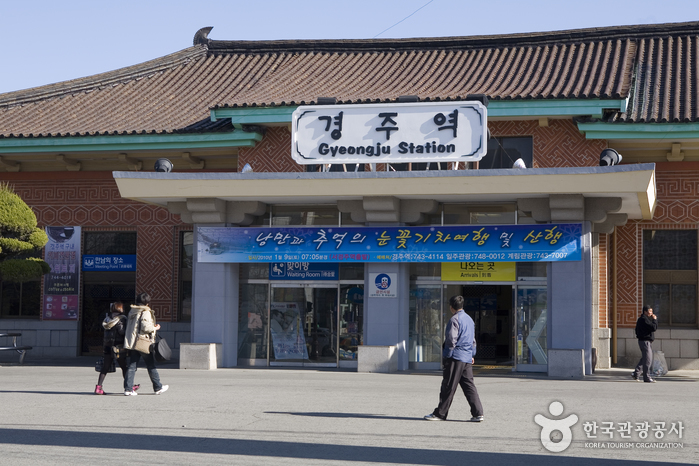
![Zone historique de Gyeongju [Patrimoine mondial de l’UNESCO] (경주역사유적지구)](http://tong.visitkorea.or.kr/cms/resource/83/202783_image2_1.jpg)
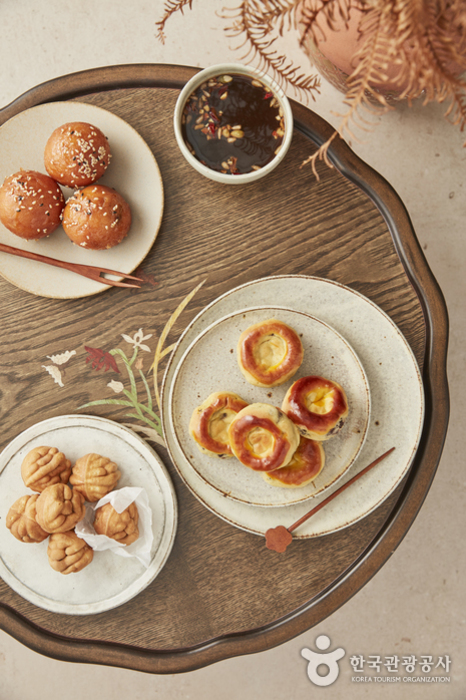
![ALLEY HOSTEL & GUESTHOUSE [Korea Quality] / 앨리게스트하우스 [한국관광 품질인증/Korea Quality]](http://tong.visitkorea.or.kr/cms/resource/80/2707780_image2_1.jpg)
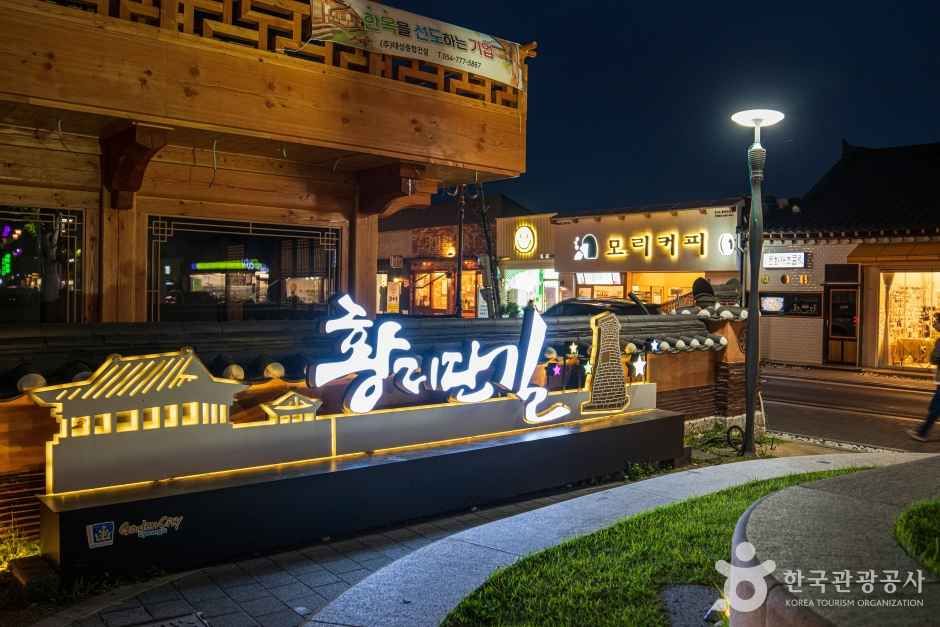
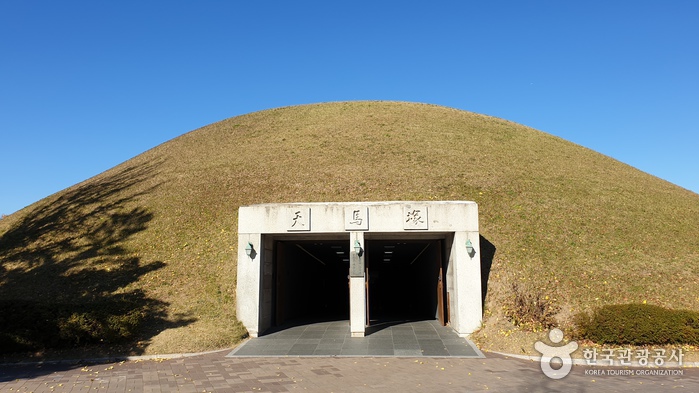
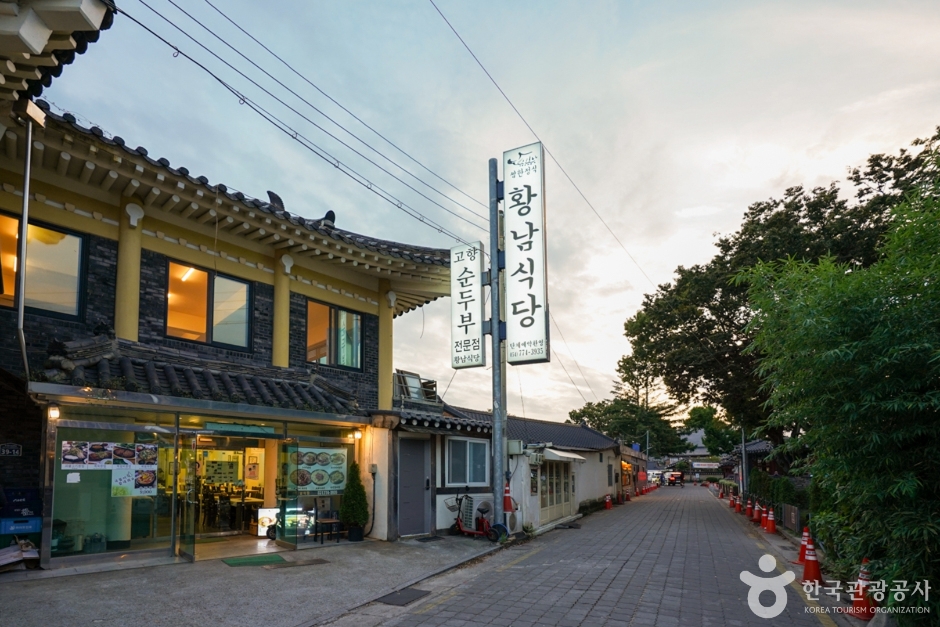
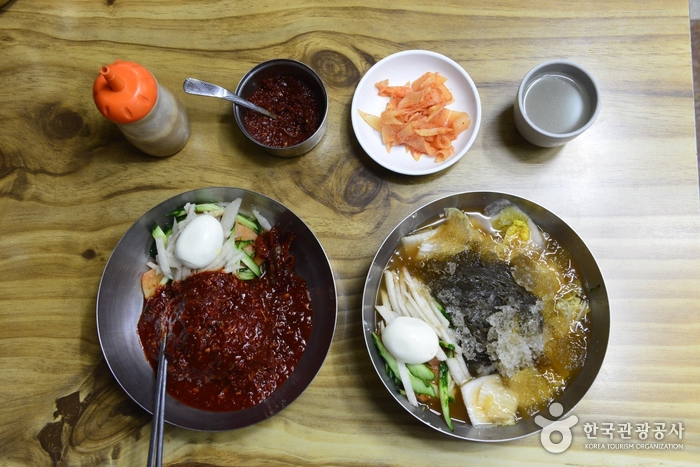
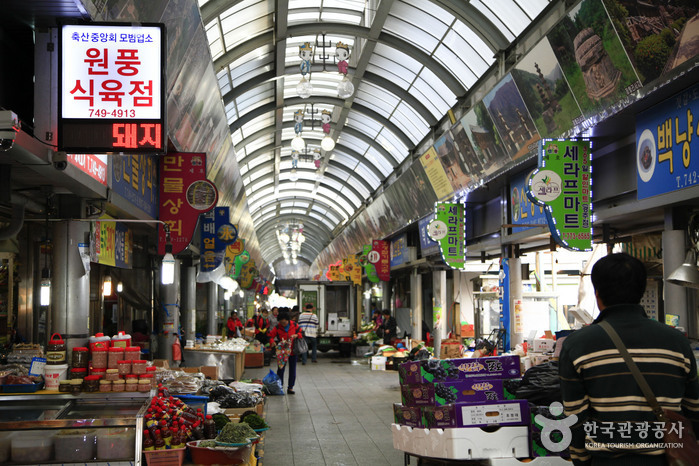
 Français
Français
 한국어
한국어 English
English 日本語
日本語 中文(简体)
中文(简体) Deutsch
Deutsch Español
Español Русский
Русский